by Jayme Radomski | Nov 14, 2017 | Clutter
Getting organized and being organized is a dream that can come true! However, an organizing journey will be most successful if you have a plan. Write down your organizing goals. Dream big and don’t hold back. Share these goals and dreams with someone to help empower you to get started. Use these tips to help with your plan and to launch you forward on your organizing journey.
Deciding Which Area of Your Home to Organize First
Deciding where to start is challenging when you have many areas of your home that need to be organized. Having a plan as to which areas you will work through first and last will help you stay focused.
Here are Some Ideas on Where to Start:
- Top Down or Bottom Up
Starting with the top of your home (or bottom) is a logical way to work through your home, organizing area by area. Start in your attic. Then work through bedrooms, bedroom closets, linen closets and bathrooms. Next work through your living room, dining room, kitchen, playroom and home office. Then the final areas would be your basement, garage, storage unit and yard.
- Inside Out
Starting with the inside of you home is another strategy. With this process, you work through all your closets and your pantry first. The next areas are the attic, basement and garage. The last areas would be bedrooms, kitchen, home office, and then living rooms and dining room.
- Areas You See Everyday
Organizing the areas of your home you see first everyday will have immediate impact and encourage you to meet your goals for other areas of your home. Areas you see everyday include your bedroom, your bathroom, your closet, kitchen and office. Choose the area with the largest impact and work through that area to completion. Enjoy the results before moving to the next.
- Areas You Do Not See Everyday
Organizing areas that you do not see everyday can be beneficial. If the organizing process will bother other family members or take an extended amount of time due to your schedule or the size and condition of the space, you may want to start with areas you do not see everyday. Working in a basement, storage area or attic where you can close a door during the process will help reduce stress for you and your family if the thought of organizing and removing unneeded items brings anxiety.
Once you have a plan of how you will work through your house, set organizing goals for each area of your home and write them down.
Where to Start with Organizing Items
You can also divide your organizing project into item categories of what you will organize first, this will bring structure to your journey. Also, write down all the items you want organized in your home to provide guidance and keep you on track.
Here are Some Ideas on How to Organize by Categorizing Your Items:
- Start Easy
Start with items that are easy to organize. These items will have obvious categories and obvious places to be stored. Items easier to organize include clothing, linens, pantry items and toys. Once the easy items are managed, move on to more difficult categories such as paperwork, kitchen items, garage items and many items typically stored in the basement. More difficult items would be saved for last, when the rest your home is organized. These items include photos, old paperwork, mementos and items that have been in storage for a long time.
- Items You Use Everyday
If you organize the items you use every day first, it will motivate you to continue to organize the rest of your home. Starting here will give you immediate gratification as you see and use these items everyday. This items include your clothing, your toiletries and your kitchen items. This area may also include items on your desk and paperwork.
- Items You Do Not Use
Organize items you do not use frequently first, this way you can free up space and energy for the items that you use frequently. Going through the items that you do not use frequently and purging the unnecessary is a good place to start if getting organized will bother other family members. They will notice a tidy space before questioning what you did with the items. These items may include tools, mementos, items from past hobbies and projects, and seasonal items.
Save the Difficult Items and Areas for Last
Start with an easy area or item. This will build motivation to continue organizing your home. Difficult items and areas include photos, mementos, basements, attics and storage units. Your family is likely to help in these areas after they see the results and enjoy the benefit of all the other organized areas of your home.
Getting organizing is a journey. Start with small projects and enjoy the results. A professional organizer can help you along the way. See if Top Shelf Home Organizing can help you on your journey. Contact Jayme to schedule a consult or chat about organizing.
by Jayme Radomski | Oct 5, 2017 | Cooking & Kitchen, Eating & Kitchen
I am sure you have heard meal planning can help you eat healthy and stick to a budget. This is true, no matter your culture, eating habits or household size, having a plan will prevent you from last minute drive-thru lunches and take and bake pizza dinners. Although we all love a simple pizza dinner every once in a while.
 Here are a couple ideas to help you to get into the habit of planning your meals.
Here are a couple ideas to help you to get into the habit of planning your meals.
Planning Meal Ideas
Jot down meal ideas to last two weeks and keep a running list with you at all times. This can be a simple notepad or a meal plan app such as Mealime, Yummly or Foodprint.
For your meal planning, double recipes for freezer meals and leftovers, and leave room for dining out. Make sure not to over plan. Over planning can lead to food waste and possibly leave you feeling burnt out from too much time in the kitchen. Keep your meals simple, especially if you do not enjoy cooking or have a busy schedule. Consider a no cook or raw meal every once in a while. In our house, we do a meal of cubed cheese, cold meat, raw veggies, fresh fruit and whole grain crackers every couple weeks. The kids love it and it works well on a busy weeknight.
You can also try meal delivery services such as Blue Apron, Sun Basket, etc. it works well as a supplement to your planning. However, be sure the meals arrive on a good day for you to actually cook the food. The food will arrive fresh and need to be prepared within a day or two. In addition, check the portion options are sufficient for your family and will produce leftovers.
Planning a Meal Budget
Identify your food budget. Be sure to include a reasonable budget for dining out. Stick to your budget by eating seasonal produce, stocking up on meat when it is on sale or purchasing protein from a local meat supplier. In your meal plan, include a couple inexpensive, non-meat meals.
Eating healthier does not have to require spending more money. A local holistic health coach can guide you to planning healthier meals without breaking the budget. Better Health by Heather has helped our family eat healthier (our kids now get a serving of veggies in their breakfast smoothies without even knowing it!).
Planning for Shopping & Preparing
Plan a day to do your grocery shopping. Take your list to your local grocery store and try your best to stick to the list. You may also consider grocery delivery. Stores may add on a minimal fee for deliver, but the cost typically is made up in the time you would spend driving and shopping.
Identify a day for food preparation. This does not need to be an entire day; just a day that you can prepare fresh produce for weekday lunches and after work and school snacking. Although, doing both shopping and food preparation in the same day may leave you feeling frustrated and burned out. Try to keep these days separated.
Have fun planning your meals and enjoy watching your family eat better. There is no perfect plan. Don’t get frustrated by wasted food or too much time in the kitchen. Learn from your mistakes and tweak your plan to best fit your household.
by Jayme Radomski | Sep 12, 2017 | Mindfulness, Nesting
 Fall brings a feeling of nesting for us all. The season change, a cold winter ahead, has us planning and preparing. Here are some ideas to help you simplify your fall nesting.
Fall brings a feeling of nesting for us all. The season change, a cold winter ahead, has us planning and preparing. Here are some ideas to help you simplify your fall nesting.
Home
Preparing your home for fall and winter can be an undertaking. Break this project down. First start by putting away summer decorations and activities. This will free up space for you to think about your fall, winter and holiday decorating. It also gives you space for cleaning. Consider items that did not bring enjoyment to you over the summer. Then, drop these items off for donation if you feel they will serve another home better.
Kitchen
Pulling out summer entertaining and outdoor dishes will free up space in your cabinets and countertops. First, clear the pantry of the summer convenience foods. Second, before your next trip to the grocery store (or delivery), empty the refrigerator. Toss items that are expired. Wipe down all shelves and walls of the refrigerator. Lastly, inventory what you have and plan some meals around those items. Jot down some favorite fall meals to make your meal planning a bit easier.
Wardrobe
September might not be the month to do a complete wardrobe changeover, but take some time to pull out the summer clothes that you did not wear, did not like or no longer make you feel great. Box them up and drop them off at a local shelter or consignment shop (to recoup a little of your investment).
Yard
Start to plan what plants will need extra attention before the winter. Arrange for fall clean up if you plan to outsource this. Then recycle and donate toys and furniture you don’t want to see in your yard next summer.
Schedule
Getting into a new schedule can be challenging, especially when you are managing multiple schedules. Don’t expect perfection. A homemade dinner may not be reasonable on an evening full of meetings or activities. Allow for the unexpected and focus on the priorities. Then the rest will fall into place in the coming weeks.
Enjoy the cooler weather. Remember to take your organizing journey one step at a time. In addition, focus on what matters and what will have the biggest impact for you.
by Jayme Radomski | Aug 22, 2017 | Bathroom
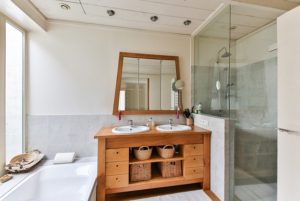 Organizing your bathroom can be fun and rewarding. Make your bathroom a relaxing place to be by following these basic bathroom organizing tips.
Organizing your bathroom can be fun and rewarding. Make your bathroom a relaxing place to be by following these basic bathroom organizing tips.
1. Cleaning
Empty all cabinets and drawers and wipe the surfaces. Hair, dust and residue tend to collect in these areas. Use an essential oil such as tea tree, lemon or orange to disinfect and add a fresh scent.
2. Make Up
When organizing and inventorying your make up combine all make up into one area. Remember to check your desk, purse, suitcase and vanity so all your makeup is inventoried. Dispose any make up that is old and expired. Donate new make up that you know you will not use to a local women’s shelter. Remove any colors that do not suit you anymore. For more great tips on organizing your make up, read more from LeAnn Conway Refresh Your Makeup Bag
3. Towels
To organize your towels follow these simple steps: Gather all bath towels, hand towels, wash clothes, etc. from around your home. Determine a reasonable number of towels per person in your home plus guests. Two bath towels, hand towels and wash clothes per person may be reasonable. Donate extra to a local animal shelter or human society. Fold the towels in a consistent way. There is no magic method to this, just fold them how they will best fit your cabinet or closet.
4. Organize
Now it is time to put all items back into the cabinets. You may want to consider purchasing some organizing supplies now that you know what you have and how you want to store it. Organizing supplies such as drawer dividers, containers, multi-level shelves, hanging shelves, or lazy Susan maybe helpful. Local hardware stores, Bed Bath & Beyond or the Container Store offer great solutions. When organizing remember to only keep what you love and need, keep like items together and find a space that fits your stuff.
If organizing your bathroom seem overwhelming, a professional organizer can help. See if Top Shelf Home Organizing can help you on your journey. Contact Jayme to schedule a consult or chat about organizing.
by Jayme Radomski | Aug 15, 2017 | Self Care, Bathroom
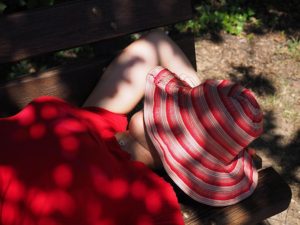 Are you spending too much money? Working too many hours? Doing too many things at one time and not paying attention to what (who) matters most? This month is the time to refocus on you, who you are and what you are grateful for. Here are a couple ideas on self care to get you refocused.
Are you spending too much money? Working too many hours? Doing too many things at one time and not paying attention to what (who) matters most? This month is the time to refocus on you, who you are and what you are grateful for. Here are a couple ideas on self care to get you refocused.
1. Reset
Rest is not negotiable when it comes to your well-being. When is the last time you felt well rested for a solid week or even a couple days? Not being well rested makes your body out of sync. Your appetite soars and you become short fused. These feelings are not good for you and the people you love. Build your schedule and routine around a day of rest. Set aside a full day to do nothing, disconnect and just be. It will make the rest of your week more productive and your relationships stronger.
2. Disconnect
Learning how to be alone and disconnect helps us connect with others. Constantly checking emails, social media feeds and other messages gives us the feeling of being connected when in reality we are alone. Being glued to the phone while the kids are playing at the park disconnects you from watching, growing and learning from your kids. Times of awkwardness at a social gathering or avoiding small talk with someone new causing you to pull out your phone so you appear to be busy is a distraction that leaves you in a state of loneliness. Learning how to be without connection to the world for a day, a couple hours, or just while waiting in a line somewhere will help you rejuvenate, focus on what relationships matter and be the best you.
3. Simplify
Self-care is challenging when you are drowning in stuff, lists and schedules. Self-care is taking care of your soul, not your stuff. Simplifying your schedule, saying no to opportunities, and reducing the stuff you own, frees your mind to focus on your well-being. Respecting your time is doing something right, not necessarily 10 things efficiently, but half-heartedly. Recognizing a habit, idea or a place that is no working for you is a start to self-care. Clear off your desk or declutter your bedroom and recognize how it makes you feel. Say ‘No’ to an opportunity and recognize when a relationship is not fitting to you. Take a mental note of how it frees your mind. Forget about keeping up and make a point to have, do and schedule what is best for you.
4. Take Care of You
Caring for your body is the most important factor in self-care. Caring for your well-being pulls all of the self-care ideas together. You are in complete control of what you do to your body from food to exercise. Choose exercise that is fitting for you; something that you can maintain, is sustainable and is easy for you to do. Improve your diet by making simple changes. Add some vegetables to your morning smoothie, think about whether you need that second cup of coffee, drink water and talk back to cravings.
by Jayme Radomski | Jul 25, 2017 | Digital, Money & Paper Management
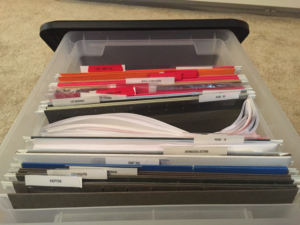 Unmanaged paperwork around your home and office can be quite stressful. Searching for important documents may seem hopeless. Interest charges and late fees can pile up quickly on misplaced bills. Deadlines are easily overlooked. Getting on top of your papers and developing a good paper management system will reduce your stress.
Unmanaged paperwork around your home and office can be quite stressful. Searching for important documents may seem hopeless. Interest charges and late fees can pile up quickly on misplaced bills. Deadlines are easily overlooked. Getting on top of your papers and developing a good paper management system will reduce your stress.
Choose a Convenient Location
Where you manage your paperwork should be convenient. Going to a secluded area of your home may not encourage you to manage your paperwork. If it is not an area you enjoy being in, you won’t go there.
The workspace should have ample surface area, basic office supplies (envelopes, pens, address label), computer and printer, paper recycle bin and paper shredder.
Remove the Unnecessary, Immediately
Sort your mail as soon as it comes in with a recycle bin and shredder within in arm’s reach. Junk mail should be recycled immediately. Refer to the document retention guideline for guidance on what documents to keep and for how long.
Do Initial Sorting
Create a temporary, simple filing system for the initial sorting of your paperwork. This file system could include files labeled:
File – for files to be filed
Pay – for bills to be paid
To Do – for items that require attention within the next month
Read – for documents that will required your dedicated attention
Regularly go through and Pay, Sort and File
Set up a weekly time to go through the temporary files. Coordinate your bill paying with your pay dates. File papers from the ‘file’ file. Review your ‘to do’ file for items needing attention within the next week. Take some time read through the files from your ‘read’ file.
Choose Physical or Electronic Files
Decide if you prefer physical or electronic files. It’s nearly impossible to completely do one or the other, but designating one or the other as your filing system will help to manage your paperwork.
It is important to always be aware of what papers, documents and receipts enter your home. Receipts can be sent via email or not retained at all. Be selective of what documents are collected at trade shows, conventions and seminars. Only accept the documents that are relevant to you. Be mindful of the mailing lists, marketing emails and promotional lists you sign up for.
Once your paperwork system is set up, plan to set aside time every week to maintain and manage your paperwork. Staying on top of your system will reduce stress and ensure you keep on top of your work and bills.
If setting up a paperwork management system is overwhelming for you, a professional organizer can help. Contact Jayme with Top Shelf Home Organizing for a consultation to see how we can help.
by Jayme Radomski | Jul 13, 2017 | Digital, Money & Paper Management
 Are your filing drawers overflowing? Do you have several stacks of paper documents with no idea as to which you need and which belong in the trash? Are you overly concerned that the IRS will come knocking at your door and you won’t have something you need? Your stress is over. This checklist on how long to keep all your financial and other important documents will help guide you!
Are your filing drawers overflowing? Do you have several stacks of paper documents with no idea as to which you need and which belong in the trash? Are you overly concerned that the IRS will come knocking at your door and you won’t have something you need? Your stress is over. This checklist on how long to keep all your financial and other important documents will help guide you!
Documents to Keep Forever
- Income tax returns
- CPA audit reports
- Deeds, mortgages and bills of sale
- Legal documents (wills, living wills, power of attorney designation, medical and burial instructions, beneficiary documents)
- Vital records (birth, death, marriage, divorce, adoption)
- Investment trade confirmations and statements that indicate buying and selling, retirement and pension records, year-end statement for investments
- Trust documents
- Receipts for warranties
- Automobile titles
- Current insurance policies
- Medical records
- Education records
- Important correspondence
- Property records (keep until sale of property)
- Car records (keep until sale of car)
- Insurance policies (keep for life of policy)
Documents to Keep for 7 Years
The IRS may go back 7 years to audit your tax returns for errors or incorrectly claimed deductions – so it’s important that you keep all tax-related documents for that length of time.
- Bank records
- W-2 and 1099 forms
- Receipts for tax purposes
- Personnel and payroll records
- Cancelled checks
- Disability records
- Unemployment benefit records
- Settled accident claims
- Mortgages, deeds, leases on sold property
- Records on sold stocks and bonds
Documents to Keep for 1 Year
It’s rare that anyone is going to want to see an electric bill or credit card statement dating back more than a year. But you may choose to keep the following NON-TAX-RELATED papers:
- Checkbook ledgers
- Paycheck stubs (keep until reconciled with W-2)
- Monthly financial statements
- Monthly mortgage statements
- Credit card statements
- Utility records
- Medical bills (in case of insurance disputes)
Documents to Keep Less Than 1 Year
There are always those papers that don’t fit into any of these categories. Retain these records according to the following guidelines:
- Credit card receipts (keep until reconciled on your credit card statement)
- ATM and deposit slips (keep until reconciled on your bank statement)
- Bills (keep until the payment verified on the next bill)
Now, it’s time to simplify!
Now that you know the guidelines on how long to keep all of your documents, it’s time to get organized. Start cleaning out those file cabinets or sorting through those paper stacks that are taking up space and causing you stress.
*NOTE: This checklist is a guideline. Please be sure to consult your accountant and/or the IRS for the most up-to-date rules.
If you don’t have the time to get your business and personal documents organized, Top Shelf Home Organizing would love to help. Call Jayme: 262-373-9416.
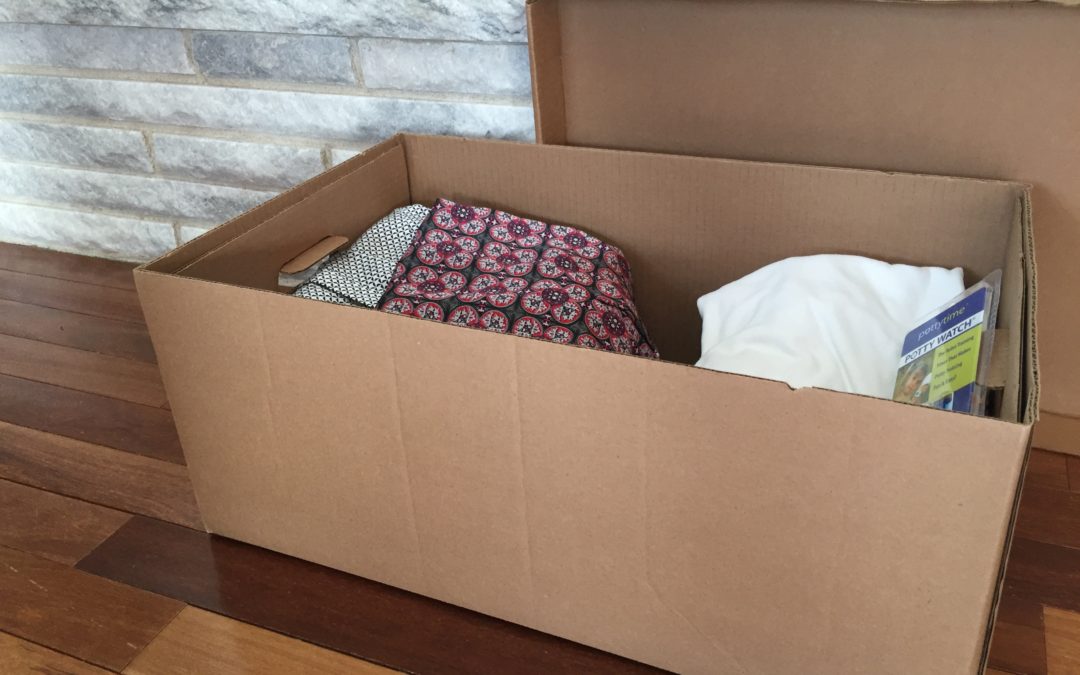
by Jayme Radomski | Mar 2, 2017 | Mindfulness, Nesting
Early spring is the season of intentional giving and sacrifices as we approach Easter. Getting organized around your home can help fulfill these seasonal traditions. Here are some tips on intentional organizing:
Plan the amount you will give to a charity, organization or family in need. Whether it is one item or one bag for forty days to charity, or an amount of money, set a goal.
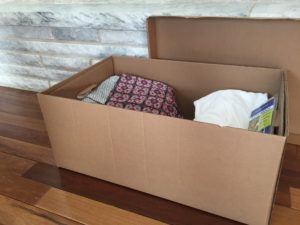
Box for charity.
Reach deeper into your own resources by allowing yourself to let go of items that are holding you back. This could be a sweater that was expensive, but no longer serves you. Maybe you have piece of exercise equipment that is collecting dust in the basement waiting for that day you start an exercise program. Items that are valuable, but no longer useful to you, are excellent ways to dig deep into giving.
Cleanse your pantry of food items that are indulgences or could be donated to a food pantry.
Pray that your household will best serve the needs of your family and nothing more. Remove the items that don’t fit your needs.
An organizer can help you on your journey to getting organized and determining the best resources for you unneeded items. Top Shelf Home Organizing helps people realize and reach their organizing goals.
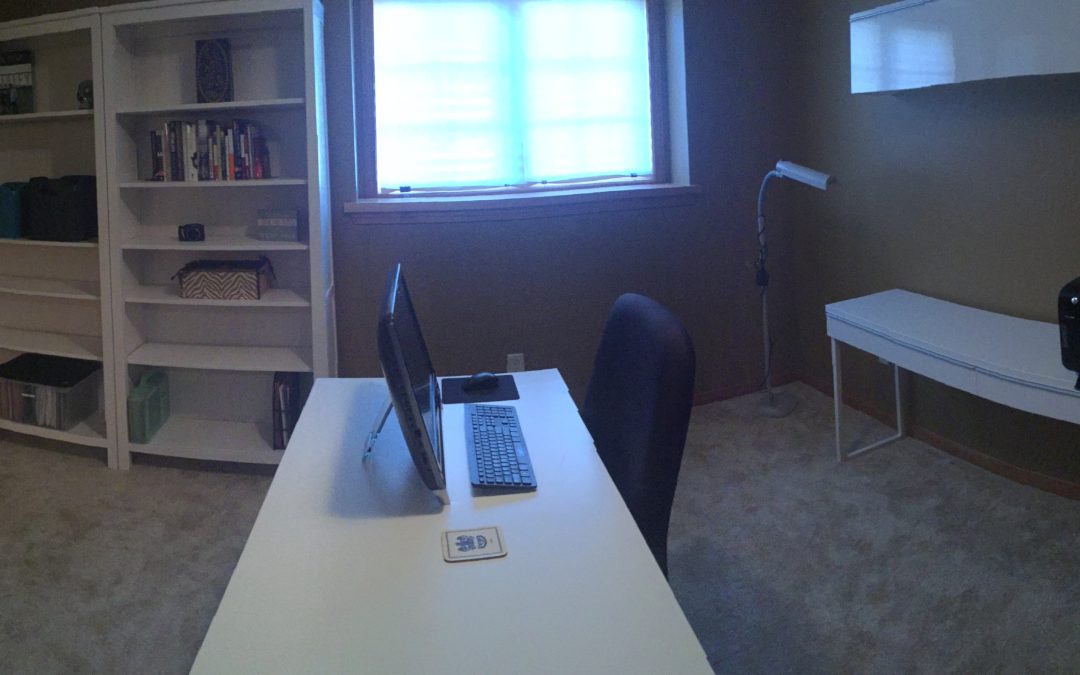
by Jayme Radomski | Dec 3, 2016 | Self Care, Bathroom
Let’s be honest, we don’t like rules. If you are serious about home organization, there are just three simple rules to follow:
- Touch It Once. This rule will save you time. When you place your hands of something, it goes to its final destination. Clothing gets put in the laundry basket or on a hanger, instead of on your bed or chair to be dealt with later. Paperwork is filed, discarded or completed as it enters your home. You are busy and managing your home is tough. Dealing with each item as you come across it, will save you time.
- Keep Like Things Together. Sweaters with sweaters. Shirts with shirts. One shelf for snacks and a shelf for cans. Designating a space for everything and keeping like items in their space will help you manage your items and save you time finding exactly what you need.
- Organize One Space At A Time. Work on one small space at a time in set increments as you have time. It might only be for fifteen or twenty minutes, but the key is to get something organized everyday. Break larger projects into manageable mini-projects.
Getting it done is the key. One small step at a time.

Organized Office
Following these simple rules every day will help keep your home clutter free and peaceful. Organizing is a process, not a destination. Top Shelf Home Organizing can help you on your journey.
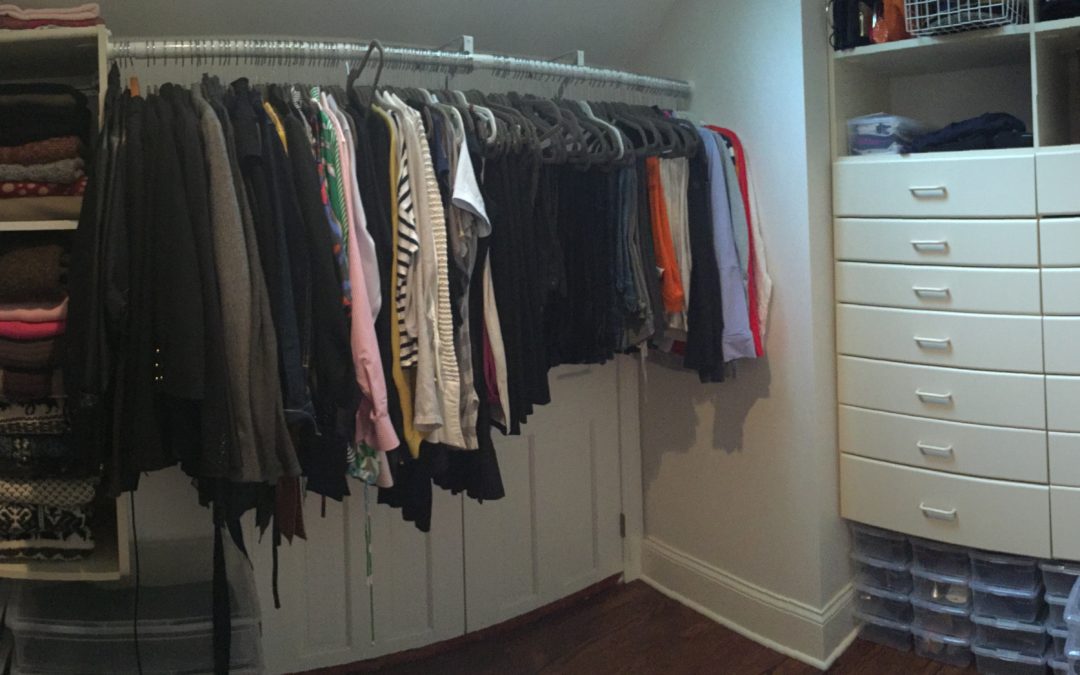
by Jayme Radomski | Sep 27, 2016 | Mindfulness, Nesting
Regular tidying and organizing can keep your home feeling peaceful and productive. Here are small stes to keep your home organized, and save you time and stress.
Store things in a place that makes sense. Drop your keys in a dish by the front door so you won’t waste time looking for them throughout the house. Put anything you need to take with you by the front door- outgoing mail, your briefcase or the library books that need to be returned. Store kids’ school gear near the door to avoid multiple last minute trips through the house to gather gear.
Straighten up as you go. Pick up the newspaper and put in the recycle bin instead of leaving it on the coffee table. Fill the dishwasher after every meal instead of once a day. Put your groceries away rather than leave them on the kitchen table. This makes the kitchen an appealing place to enjoy a meal instead of a constant reminder of chores that need to be done.
Finish one project before starting another. Having too many projects going on at one time is overwhelming.
Tidy your bathroom. Wipe up the sink and vanity top after you shave or wash your face and put your toiletries away. Doing these small things as you go keeps the bathroom cleaner.
Organize your closets. If your closet is filled to capacity, you can’t see what you have. Keep shoes in boxes or shoe racks. Donate any garments that no longer fit or if you haven’t worn them in the past season. Donate items you don’t need or love; someone will be grateful to take them.
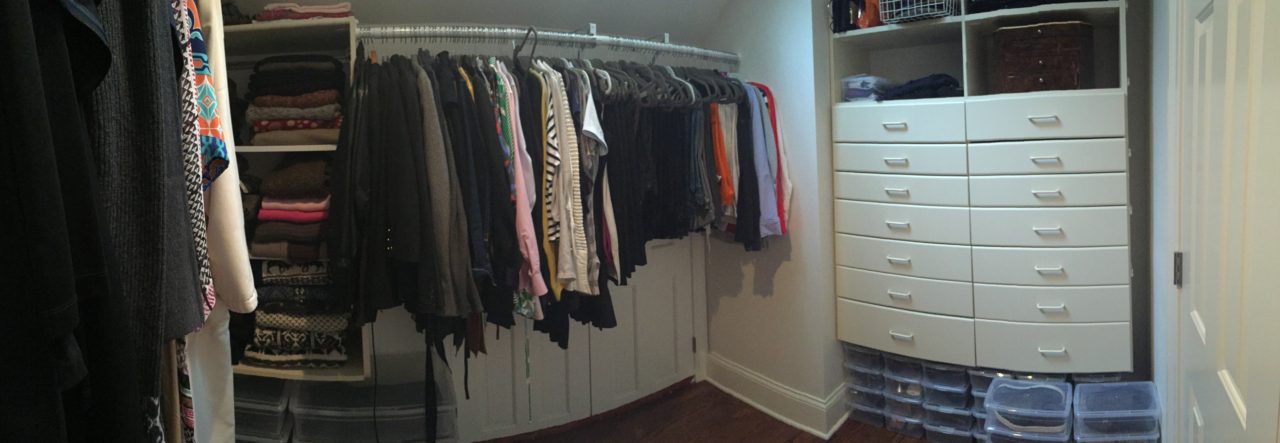
Closet organized by clothing category for simplified mornings.
File your important documents and papers in a safe place. Birth certificates, passports, marriage license, divorce papers, the deed to your house and the title to your car should be filed in a fireproof lockbox or in a safe deposit box at a bank. Back up important financial information that is on your home computer.
Taking small steps every day to keep organized will help keep your home clutter free and peaceful. Organizing is a process, not a destination. Top Shelf Home Organizing can help you on your journey.













